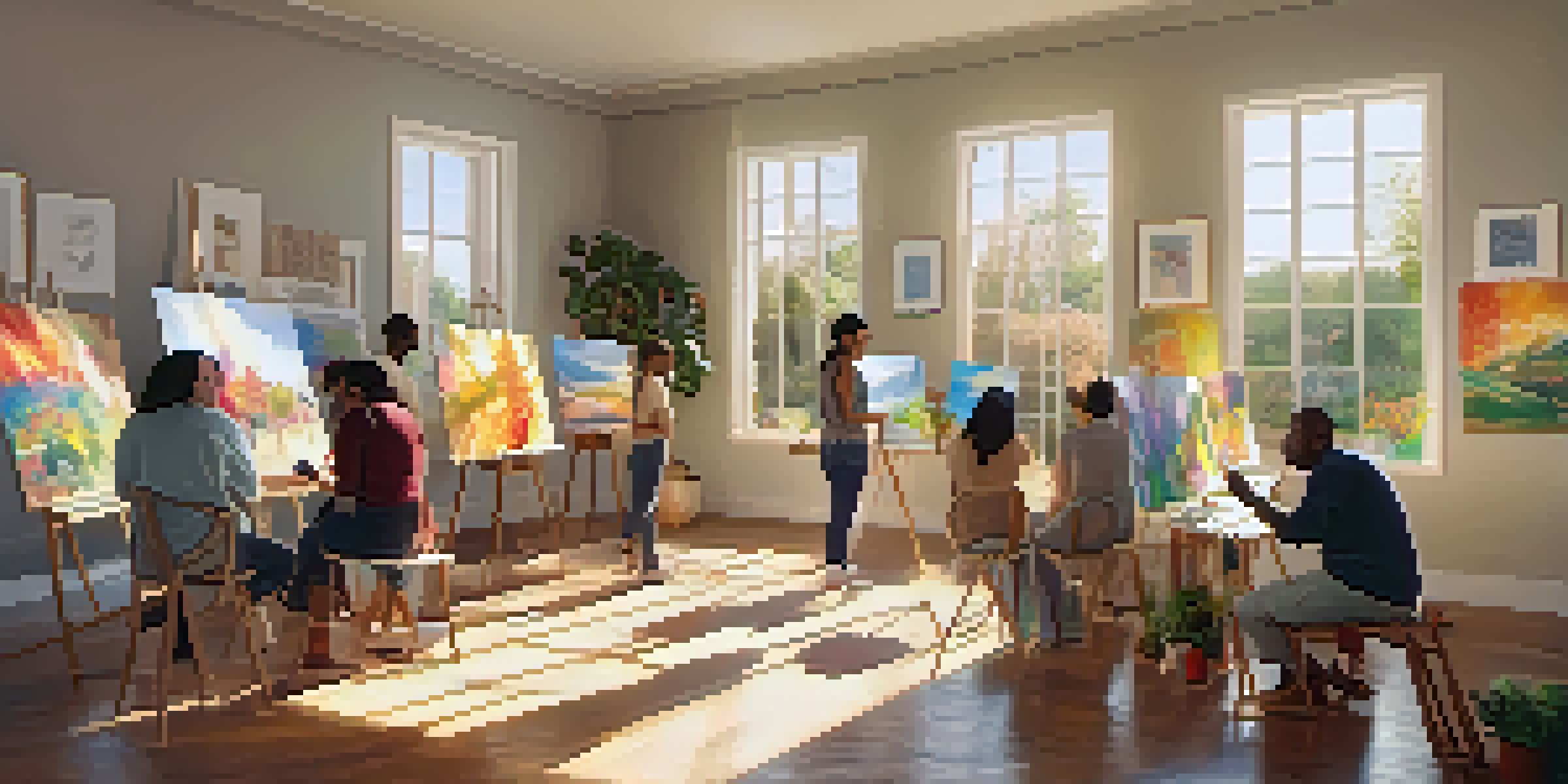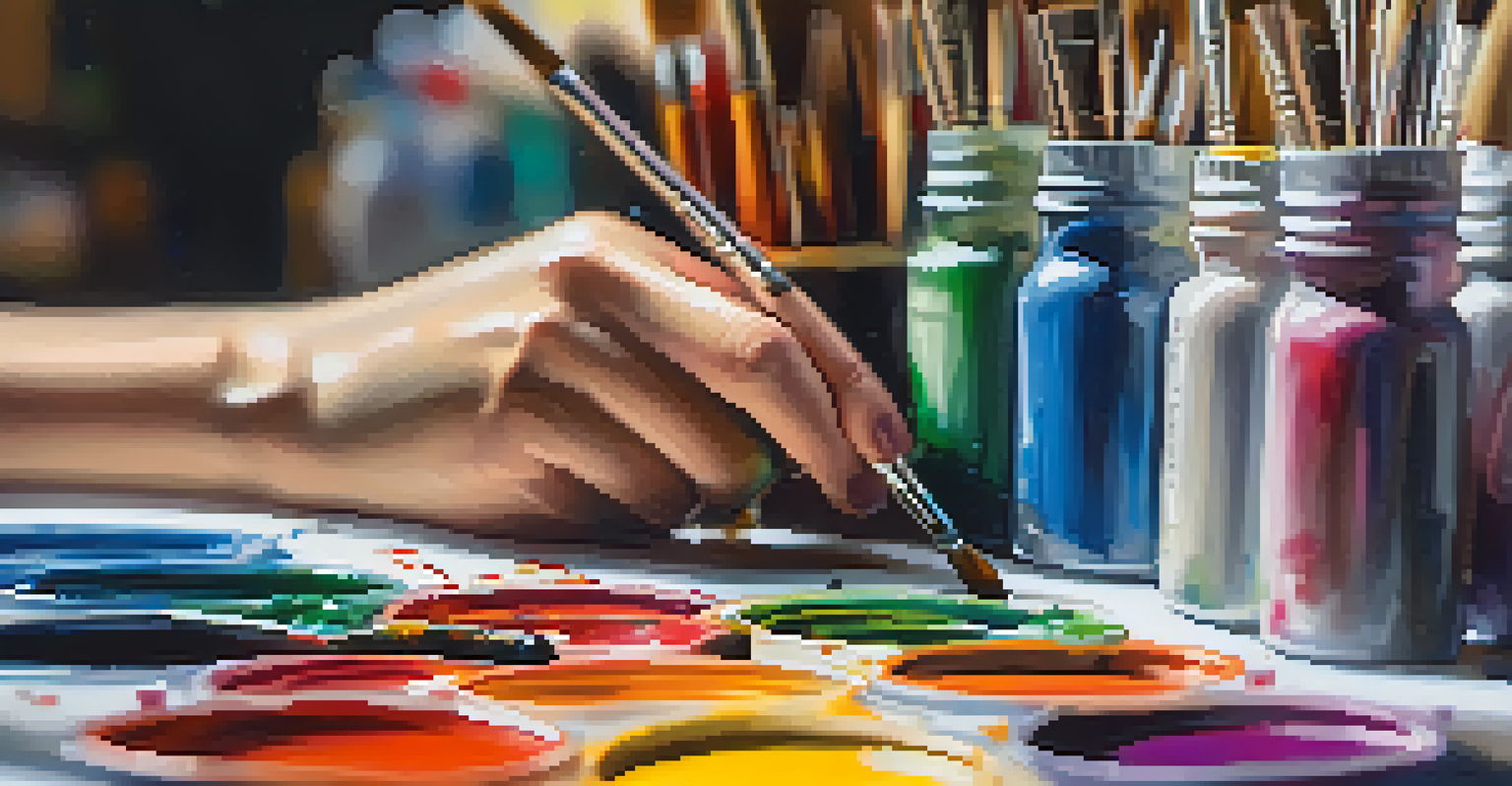The Role of Art in Addressing Mental Health and Stigma

Art as a Form of Expression for Mental Health
Art serves as a powerful outlet for individuals struggling with mental health issues. It allows them to express feelings that might be difficult to articulate in words. Through painting, music, or writing, they can explore their emotions and experiences, making the invisible aspects of their struggles more visible.
Art is not what you see, but what you make others see.
For many, creating art can be a therapeutic process, providing relief and a sense of control. This creative expression often encourages self-reflection and emotional healing, leading to personal insights. It’s like having a conversation with oneself, where colors, melodies, or words can convey what’s often left unsaid.
Moreover, sharing their art with others can foster connection and understanding. When people see the emotions behind the art, it opens doors for dialogue about mental health, reducing feelings of isolation and loneliness. This shared experience can greatly enhance the healing journey.
Art as a Tool for Raising Awareness About Mental Health
Art has the unique ability to communicate complex issues in a relatable way, making it an ideal medium for raising awareness about mental health. Through visual storytelling, artists can portray the challenges faced by those with mental health conditions, sparking conversations that might not happen otherwise. This can help demystify mental health issues and educate the public.

For instance, community art projects or exhibitions focused on mental health can attract diverse audiences, drawing their attention to important topics. These events often serve as safe spaces where people can engage with the art and the issues it represents. It’s a way to bring people together, breaking down barriers and promoting understanding.
Art as Healing for Mental Health
Creating art helps individuals express emotions and fosters emotional healing.
As viewers connect emotionally with the artwork, they may find themselves reflecting on their perceptions of mental health. This shift in perspective can lead to greater empathy and a reduction in stigma, as art humanizes the experiences of those living with mental health challenges.
The Role of Art Therapy in Mental Health Treatment
Art therapy is a specialized field that harnesses the creative process to enhance the well-being of individuals facing mental health challenges. This therapeutic approach encourages clients to create art while a trained therapist guides them, providing a safe space for exploration. It’s not about creating a masterpiece; it's about the journey of self-discovery and expression.
Every artist dips his brush in his own soul, and paints his own nature into his pictures.
Research shows that art therapy can lead to significant improvements in emotional and psychological health. Participants often report reduced anxiety and increased self-esteem, as the act of creating helps them process their feelings in a constructive manner. It’s like having a toolkit for managing emotions, where art becomes a vital resource.
Moreover, art therapy can be particularly beneficial for those who have difficulty expressing themselves verbally. For individuals who find traditional talk therapy challenging, art provides an alternative means of communication. This can lead to breakthroughs in understanding and healing.
Challenging Stigma Through Artistic Narratives
Art has the power to challenge societal stigma surrounding mental health by presenting authentic narratives. When artists share their personal experiences through their work, they humanize the struggle, making it relatable for others. This vulnerability can inspire viewers to reconsider their preconceived notions about mental illness.
For instance, graphic novels, films, and performances that depict mental health issues can resonate deeply with audiences. They often highlight the complexities of mental health, showcasing both the struggles and the resilience of individuals. This storytelling aspect can create a sense of community, connecting those who may feel alone in their experiences.
Art Raises Mental Health Awareness
Art effectively communicates complex mental health issues, sparking important conversations.
As more artists use their platforms to share these narratives, the conversation around mental health becomes more normalized. This shift helps break down the stigma, encouraging more people to seek help and support without fear of judgment.
Community Engagement Through Art Initiatives
Community art initiatives are a fantastic way to engage people in discussions about mental health. These projects, whether murals, workshops, or performances, invite diverse groups to collaborate and express themselves creatively. This collective effort can foster a sense of belonging and shared purpose, making mental health a community concern.
Local organizations often host events that blend art and mental health awareness, creating a supportive environment for individuals to share their stories. When communities come together to create, it strengthens bonds and encourages open dialogue about mental health challenges. It’s like planting seeds of awareness that can grow into a more understanding and supportive society.
Additionally, these initiatives often attract media attention, further amplifying the message. As more people engage with these community projects, the stigma surrounding mental health diminishes, paving the way for acceptance and healing.
The Healing Power of Arts in Personal Recovery
For many individuals on their mental health recovery journey, engaging with the arts can be incredibly healing. Whether it's painting, dancing, or playing an instrument, these activities can provide a sense of accomplishment and joy. This positive engagement serves as a reminder that despite their struggles, they can still create and express beauty.
Art also offers a distraction from negative thoughts and feelings, allowing individuals to immerse themselves in a creative process. This can bring a sense of peace and clarity, helping them to cope better with their mental health challenges. It’s like stepping into a different world where creativity reigns, providing a break from the chaos.
Community Art Initiatives Matter
Collaborative art projects strengthen community bonds and promote open discussions about mental health.
Moreover, the act of creating can boost self-esteem and encourage a positive self-image. As individuals see their creations come to life, they often feel a renewed sense of purpose and identity, which is essential for recovery. This empowerment through creativity can be a transformative experience.
Art as a Catalyst for Change in Mental Health Policies
Art not only impacts individual experiences but can also drive systemic change in mental health policies. Artists and advocates have the power to influence public opinion and policy through their work. By shedding light on mental health issues, they can inspire action and foster legislative changes that prioritize mental health.
Campaigns that utilize art to communicate mental health messages can mobilize communities and create momentum for change. For example, visual campaigns or performances can highlight gaps in mental health services, prompting conversations among policymakers. This artistic advocacy ensures that mental health remains a priority on the public agenda.

As art continues to play a role in shaping mental health discourse, it empowers individuals to voice their needs and experiences. This collective push for change can lead to improved mental health resources and support systems, ultimately benefiting society as a whole.